Hubble witnesses an asteroid mysteriously disintegrating

The NASA/ESA Hubble Space Telescope has
photographed the never-before-seen break-up of an asteroid, which has
fragmented into as many as ten smaller pieces. Although fragile comet
nuclei have been seen to fall apart as they approach the Sun, nothing
like the breakup of this asteroid, P/2013 R3, has ever been observed
before in the asteroid belt.
"This is a rock. Seeing it fall apart before our eyes is pretty amazing," said David Jewitt of UCLA, USA, who led the astronomical forensics investigation.The crumbling asteroid, designated P/2013 R3, was first noticed as an unusual, fuzzy-looking object on 15 September 2013 by the Catalina and Pan-STARRS sky surveys. Follow-up observations on 1 October with the Keck Telescope on Mauna Kea, Hawaii, revealed three co-moving bodies embedded in a dusty envelope that is nearly the diameter of Earth.
"Keck showed us that this thing was worth looking at with Hubble,” Jewitt said. With its superior resolution, the space-based Hubble observations soon showed that there were really ten distinct objects, each with comet-like dust tails. The four largest rocky fragments are up to 200 metres in radius, about twice the length of a football pitch.
The Hubble data showed that the fragments are drifting away from each other at a leisurely 1.5 kilometres per hour — slower than the speed of a strolling human. The asteroid began coming apart early last year, but the latest images show that pieces continue to emerge.
"This is a really bizarre thing to observe — we've never seen anything like it before,” says co-author Jessica Agarwal of the Max Planck Institute for Solar System Research, Germany. "The break-up could have many different causes, but the Hubble observations are detailed enough that we can actually pinpoint the process responsible.”
The ongoing discovery of more fragments makes it unlikely that the asteroid is disintegrating due to a collision with another asteroid, which would be instantaneous and violent in comparison to what has been observed. Some of the debris from such a high-velocity smash-up would also be expected to travel much faster than has been observed.
It is also unlikely that the asteroid is breaking apart due to the pressure of interior ices warming and vaporising. The object is too cold for ices to significantly sublimate, and it has presumably maintained its nearly 480-million-kilometre distance from the Sun for much of the age of the Solar System.
This leaves a scenario in which the asteroid is disintegrating due to a subtle effect of sunlight that causes the rotation rate to slowly increase over time. Eventually, its component pieces gently pull apart due to centrifugal force. The possibility of disruption by this phenomenon — known as the YORP effect [1] — has been discussed by scientists for several years but, so far, never reliably observed (eso1405).
For break-up to occur, P/2013 R3 must have a weak, fractured interior, probably the result of numerous ancient and non-destructive collisions with other asteroids. Most small asteroids are thought to have been severely damaged in this way, giving them a "rubble pile” internal structure. P/2013 R3 itself is probably the product of collisional shattering of a bigger body some time in the last billion years.
"This is the latest in a line of weird asteroid discoveries, including the active asteroid P/2013 P5, which we found to be spouting six tails,” says Agarwal. "This indicates that the Sun may play a large role in disintegrating these small Solar System bodies, by putting pressure on them via sunlight.”
P/2013 R3's remnant debris, weighing in at 200 000 tonnes, will provide a rich source of meteoroids in the future. Most will eventually plunge into the Sun, but a small fraction of the debris may one day blaze across our sky as meteors.
Notes
[1] In full, this effect is known as the Yarkovsky–O'Keefe–Radzievskii–Paddack effect. This effect occurs when light from the Sun is absorbed by a body and then re-emitted as heat. When the shape of the emitting body is not perfectly regular, more heat is emitted from some regions than others. This creates a small imbalance that causes a small but constant torque on the body, which changes its spin rate.
Asteroid P/2013 R3 breaks apart

This series of images shows the asteroid P/2013 R3 breaking apart, as viewed by the NASA/ESA Hubble Space Telescope in 2013. This is the first time that such a body has been seen to undergo this kind of break-up.
The Hubble observations showed that there are ten distinct objects, each with comet-like dust tails, embedded within the asteroid's dusty envelope. The four largest rocky fragments are up to 200 metres in radius, about twice the length of a football pitch.
The date increases from left to right, with frames from 29 October 2013, 15 November 2013, 13 December 2013, and 14 January 2014 respectively, showing how the clumps of debris material move around. The 14 January 2014 frame was not included in the science paper and is additional data.
Credit:
NASA, ESA, D. Jewitt (UCLA)
Asteroid P/2013 R3 breaks apart (labelled)

The Hubble observations showed that there are ten distinct objects, each with comet-like dust tails, embedded within the asteroid's dusty envelope. The four largest rocky fragments are up to 200 metres in radius, about twice the length of a football pitch.
The dates on which the various observations were taken are marked at the bottom of each image, with frames from 29 October 2013, 15 November 2013, 13 December 2013, and 14 January 2014 respectively. The 14 January 2014 frame was not included in the science paper and is additional data.
Credit:
NASA, ESA, D. Jewitt (UCLA)
Disintegrating asteroid P/2013 R3 as viewed by Hubble on 29 October 2013
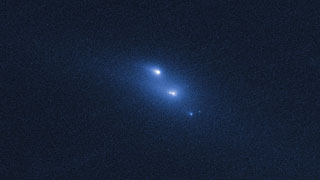
This image shows NASA/ESA Hubble Space Telescope observations of
asteroid P/2013 R3. This asteroid has been found to be disintegrating
and breaking apart — the first such body ever seen to do this.
This image shows P/2013 R3 as it was seen on 29 October 2013.
Credit:
NASA, ESA, D. Jewitt (UCLA)
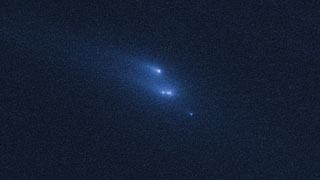
This image shows P/2013 R3 as it was seen on 29 October 2013.
Credit:
NASA, ESA, D. Jewitt (UCLA)
Disintegrating asteroid P/2013 R3 as viewed by Hubble on 15 November 2013

This image shows NASA/ESA Hubble Space Telescope observations of
asteroid P/2013 R3. This asteroid has been found to be disintegrating
and breaking apart — the first such body ever seen to do this.
This image shows P/2013 R3 as it was seen on 15 November 2013.
Credit:
NASA, ESA, D. Jewitt (UCLA)
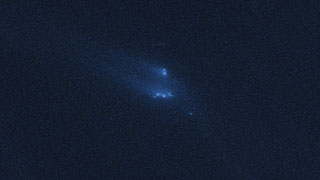
This image shows P/2013 R3 as it was seen on 15 November 2013.
Credit:
NASA, ESA, D. Jewitt (UCLA)
Disintegrating asteroid P/2013 R3 as viewed by Hubble on 13 December 2013

This image shows NASA/ESA Hubble Space Telescope observations of
asteroid P/2013 R3. This asteroid has been found to be disintegrating
and breaking apart — the first such body ever seen to do this.
This image shows P/2013 R3 as it was seen on 13 December 2013.
Credit:
NASA, ESA, D. Jewitt (UCLA)
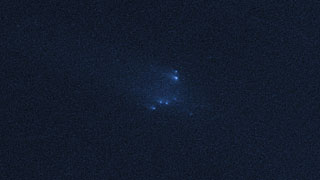
This image shows P/2013 R3 as it was seen on 13 December 2013.
Credit:
NASA, ESA, D. Jewitt (UCLA)
Disintegrating asteroid P/2013 R3 as viewed by Hubble on 14 January 2014

This image shows NASA/ESA Hubble Space Telescope observations of
asteroid P/2013 R3. This asteroid has been found to be disintegrating
and breaking apart - the first such body ever seen to do this.
This image shows P/2013 R3 as it was seen on 14 January 2014. This frame was not included in the science paper and is additional data.
Credit:
NASA, ESA, D. Jewitt (UCLA)
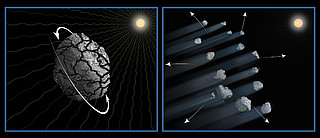
This image shows P/2013 R3 as it was seen on 14 January 2014. This frame was not included in the science paper and is additional data.
Credit:
NASA, ESA, D. Jewitt (UCLA)
Artist's illustration of disintegrating asteroid P/2013 R3

This illustration shows one possible explanation for the disintegration of asteroid P/2013 R3.
It is likely that over the past 4.5 billion years the asteroid was fractured by collisions with other asteroids. The effects of sunlight will have caused the asteroid to slowly increase its rotation rate until the loosely bound fragments drifted apart due to centrifugal forces. Dust drifting off the pieces makes the comet-looking tails. This process may be common for small bodies in the asteroid belt.
Credit:
NASA, ESA, D. Jewitt (UCLA), and A. Feild (STScI)
VIDEO-VIDEO
It is likely that over the past 4.5 billion years the asteroid was fractured by collisions with other asteroids. The effects of sunlight will have caused the asteroid to slowly increase its rotation rate until the loosely bound fragments drifted apart due to centrifugal forces. Dust drifting off the pieces makes the comet-looking tails. This process may be common for small bodies in the asteroid belt.
Credit:
NASA, ESA, D. Jewitt (UCLA), and A. Feild (STScI)
VIDEO-VIDEO
The breakup of asteroid P/2013 R3
This video shows a number of NASA/ESA Hubble Space Telescope
observations of asteroid P/2013 R3, as viewed over a time period of just
over two months in 2013. The fragments are visible moving around, and
new chunks of material appear as time passes.
The observations were taken using Hubble on 29 October 2013, 15 November 2013, 13 December 2013, and 14 January 2014.
Credit:
The observations were taken using Hubble on 29 October 2013, 15 November 2013, 13 December 2013, and 14 January 2014.
Credit:
Fuente: ESA/Hubble Information Centre
The ESO Education and Public Outreach Department
Comentarios